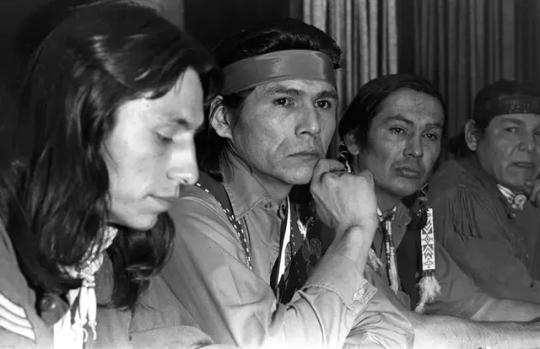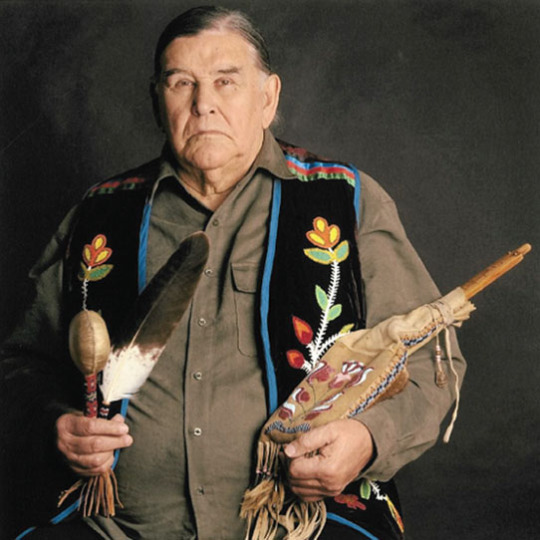#eddie benton-banai
Explore tagged Tumblr posts
Text

L to R: John Trudell, Dennis Banks, Russell Means, and Eddie Benton-Banai of the American Indian Movement (1971)
#john trudell#dennis banks#russell means#eddie benton-banai#indigenous#activist#poet#1971#actor#musician#american indian movement#indigenous american
238 notes
·
View notes
Text


Clyde Bellecourt and the American Indian Movement
Clyde Bellecourt, activist and one of the most important leaders of the American Indian Movement, died of cancer on January 11, 2022 at his home in Minneapolis.
In 1968, Bellecourt, along with Dennis Banks, Eddie Benton-Banai and others, founded what would become known as the American Indian Movement (AIM), an organization advocating for the rights of Native Americans locally and later nationwide. Under Bellecourt’s leadership, AIM staged numerous protests, marches, and takeovers including the 71-day occupation of Wounded Knee, S.D. in 1973, which highlighted corruption on the reservation and demanded reopening of treaty negotiations to provide fair and equitable treatment of Native Americans. AIM, along with Bellecourt, also founded the first Indian urban-based health care provider in the nation (Indian Health Board), helped launch a community-owned law firm (Legal Rights Center) in Minneapolis, founded Heart of the Earth Survival School, opened and operated Little Earth housing development, and founded the American Indian Opportunities Industrial Center, among many other accomplishments.
Learn more about Clyde Bellecourt in his 2016 autobiography, Thunder Before the Storm. You can also find newspaper clippings, photographs, and newsletters from the American Indian Movement in Special Collections at Hennepin County Library.
Photos of Clyde Bellecourt from the Star Tribune Photograph Collection, Hennepin County Library Special Collections.
#Minneapolis#Minnesota#Clyde Bellecourt#American Indian Movement#AIM#Native Americans#Indian rights#activists#civil rights#civil rights leaders
191 notes
·
View notes
Text
Remembering AIM Co-Founder Clyde Bellecourt

A few days ago, we lost an icon of our time. Clyde Howard Bellecourt (May 8, 1936 – January 11, 2022) was a Native American civil rights organizer. An Anishinaabe (Ojibwe) activist from the White Earth Reservation, he co-founded the American Indian Movement (AIM) in Minneapolis in 1968 with Dennis Banks, Eddie Benton-Banai and George Mitchell. For years, Bellecourt worked to address issues of poverty and police brutality against Native people. He remained active throughout his long life, eventually becoming a strong advocate for eliminating offensive sports mascots. His Anishinaabe name, Nee-gon-we-way-we-dun, means "Thunder Before the Storm."
Under Bellecourt's leadership, AIM raised awareness of tribal issues related to the federal government, monitored police harassment in Minneapolis, created welfare programs for urban Indians, and founded Indian "survival schools" in the Twin Cities to teach children life skills and to help them learn their traditional cultures. He initiated the Trail of Broken Treaties, a long march to Washington, D.C., in 1972 to serve as a first step to renegotiating federal-tribal nations' treaties and relations. In addition, he founded non-profit groups to undertake economic development to benefit Native Americans.
He became a negotiator at the occupation of Wounded Knee on the Pine Ridge Indian Reservation, the site of an infamous 1890 massacre of more than 300 Lakota by the U.S. Cavalry. The Wounded Knee Occupation began on February 27, 1973 when about 200 Oglala Lakota and followers of AIM seized and occupied the town of Wounded Knee, South Dakota. The occupation lasted for a total of 71 days, during which time two Lakota men were shot to death by federal agents and several more were wounded. It was a key moment in the struggle for Native American rights.
In 1993, Bellecourt and others led protests against police brutality in Minneapolis when two intoxicated Native men were driven to the hospital in the trunk of a squad car. Bellecourt continued to direct national and international AIM activities. He coordinated the National Coalition on Racism in Sports and the Media, which has long protested sports teams use of Native American mascots and names, urging them to end such practices; the Washington Redskins finally dropped their mascot in 2020 in response to years of protests. He also led Heart of the Earth, Inc., an interpretive center located behind the site of AIM's former "survival school," which operated from 1972 to 2008 in Minneapolis.
Bellecourt died of cancer on January 11, 2022, at the age of 85. At the time of his death, Bellecourt was the last surviving co-founder of the American Indian Movement. Minnesota Governor Tim Walz stated, "Clyde Bellecourt sparked a movement in Minneapolis that spread worldwide. His fight for justice and fairness leaves behind a powerful legacy that will continue to inspire people across our state and nation for generations to come." According to Minnesota Lt. Governor Peggy Flanagan, Bellecourt was a "civil rights leader who fought for more than a half-century on behalf of Indigenous people in Minnesota and around the world. Indian Country benefited from Clyde Bellecourt's activism."
#clyde bellecourt#american indian movement#AIM#civil rights activist#remembrance#native americans#indigenous rights
84 notes
·
View notes
Quote
Benton-Banai, who is Anishinaabe Ojibwe, was born and raised on the Lac Courte Oreilles reservation in northern Wisconsin. He made a life of connecting American Indians with their spirituality and promoting sovereignty, and was the grand chief, or spiritual leader, of the Three Fires Midewiwin Lodge. Day said he was someone people looked to for guidance in the religious practice of the Anishinaabe Ojibwe people – and he gave countless babies their traditional names. Benton-Banai’s place in the American Indian Movement, a grassroots group formed in 1968, can be traced to his launch of a cultural program in a Minnesota prison, said co-founder Clyde Bellecourt. Bellecourt was in solitary confinement when he heard someone whistling You are My Sunshine, and he looked through a tiny hole in his cell and saw Benton-Banai, a fellow inmate, recognizing him as an Indigenous man. Bellecourt said Benton-Banai approached him about helping incarcerated Indigenous people, and they started the prison’s cultural program to teach American Indians about their history and encourage them to learn a trade or seek higher education. Bellecourt said Benton-Banai thought they could do the same work in the streets, and the program morphed into the American Indian Movement, an organization that persists today with various chapters. “It started because I met Eddie in jail,” Bellecourt said. “Our whole Indian way of life came back because of him … My whole life just changed. I started reading books about history of the Ojibwe nation … dreaming about how beautiful it must have been at one time in our history.”
Eddie Benton-Banai, co-founder of American Indian Movement, dies aged 89 | Native Americans | The Guardian
4 notes
·
View notes
Text

DAY 2: History
Oh boy where to start...literally Anishinaabe history is my field of study. Let’s maybe do a rough timeline?
Over 500 years ago: Anishinaabe people migrated from the east coast to the Great Lakes region, in the process splitting into the various different communities.
1600s: Anishinaabe people encounter Europeans for the first time (possibly earlier but this was the first major encounter). They begin to trap more furs to trade with them. Competition and death from diseases result in major wars between the Anishinaabeg and Haudenosaunee peoples.
1700s: Anishinaabe people spread further west, which disturbs the Dakota people who they begin to battle frequently. Their foreign policy involves playing the French and British off each other in the first half of the century, then the British and Americans in the later part.
1800s: Many Americans and Canadians enter Anishinaabewaki during this time, displacing Anishinaabe people. Both states make treaties with Anishinaabe communities resulting in the creations of reserves in Canada and reservations in the US. By the end of the century, in all but the most northern areas, Anishinaabeg are now minorities in their own homelands.
1900s: The US and Canadian governments force Anishinaabe children to attend boarding/residential schools where they cannot speak their language and are often abused while forcibly assimilating them. But by mid-century Anishinaabe people in both the US and Canada are organizing for their collective rights and sovereignty as nations.
2000s: There is a resurgence of culture and language all across Anishinaabewaki. Resource extraction and the pollution of lands and bodies by corporations is a major issue.
That takes us to today!

(map by Eddie Benton-Banai, in “The Mishomis Book”)
Related vocabulary
gaa-ezhiwebak mewinzha - history agwi'idiwin/nakondiwin- treaty ishkonigan - reserve/reservation (literally "what remains, leftover") dibenindizowin - sovereignty, freedom biskaabiiyang - decolonization (litetally "returning") nibi gaa-bimaaji'iwemagak - water is life (literally "water that makes people live")
33 notes
·
View notes
Text
Clyde Bellecourt, a Founder of the American Indian Movement, Dies at 85
Clyde Bellecourt, a Founder of the American Indian Movement, Dies at 85
Clyde attended a Roman Catholic mission school run by Benedictine nuns on the reservation until he was a teenager. The family then moved to Minneapolis, where he struggled academically, dropped out of high school, failed to find a job and was jailed for burglaries and robberies. In prison, he met Mr. Banks and Eddie Benton-Banai, who was running a cultural program for Native American inmates.…

View On WordPress
0 notes
Photo

ATTENTION ALL: It is with an extremely heavy heart that I have to bring this news to the Ohio community. Today Eddie Benton Banai, Co-founder of the American Indian Movement, walked on to the Spirit World. We ask for prayers for him and his family. Tobacco down, smoke up Eddie. May your journey be swift. Philip Yenyo Executive Director American Indian Movement of Ohio https://www.instagram.com/p/CIRHQpMFEh4/?igshid=1ip3x9r3wtu7
0 notes
Photo




50th Anniversary: Founding of the American Indian Movement
Fifty years ago today--July 28, 1968--the American Indian Movement (AIM) was founded in Minneapolis. Meeting in an office on Plymouth Avenue North, Clyde Bellecourt, Dennis Banks, Herb Powless, Eddie Benton Banai, and roughly 100 other community members formally organized the Concerned Indian American Coalition (CIA). Within the first year, CIA had become AIM.
Throughout its history, AIM has actively worked for the rights and opportunities of American Indians. The organization may be best known for its occupation of Wounded Knee in 1973, but AIM’s initial focus was rights of Native Americans in Minneapolis. One of AIM’s first programs was the AIM Patrol, a citizen’s patrol of community members that monitored community-police interactions along East Franklin Avenue. Other early goals included housing programs, youth activities, broadening employment opportunities, and improving education. As AIM explained in 1969, its main objective was “to solicit and broaden opportunities for the urban Indian in order that he may enjoy his full rights a a citizen of these United States.”
Materials pictured are from the Hennepin County Library Special Collections vertical files. AIM newsletters and other resources on AIM are available for use in Special Collections.
#minneapolis#minnesota#american indian movement#civil rights#native americans#american indians#1968#1960s
38 notes
·
View notes